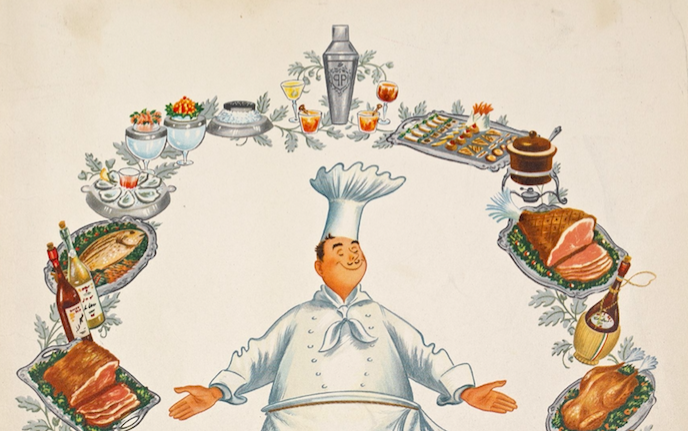archive
Eat, Post, and Fork History.
An introduction to the course “Digital History: Foodways and the Forking of History”

Source: NYPL Labs Project “What’s on the menu?” Oak Room Restaurant Menu, The Plaza Hotel, USA November 15, 1958
Taught by Professor Elizabeth Hopwood, the newest member of the CTSDH faculty, the course Digital History: Foodways and the Forking of History (HIST 300-01W) analyzes the role of food in shaping national histories and cultural experiences, while exploring new ways to write and rewrite history by using digital media. This course focuses on the study of foodways in North America and the Caribbean from the nineteenth century to the present. During the fall semester, Hopwood’s students are exploring topics as diverse as the theoretical underpinnings of food studies, the relationship between Halloween and candy throughout history, and the relationship between sugar production and slavery in the Caribbean.
This course asks undergraduates to reflect on how we write history, what history means, and how media affects our understanding of both. “One of the goals of this course,” Dr. Hopwood explains, “is to think about how food writes history, and through what texts (recipes, cookbooks, advertisements, novels, slave narratives), so it is equally important that we consider our own engagement with text, medium, and genre. I want my students to think carefully and critically about what it means to write across new media: what are the affordances of composing in both public and private spaces, and in working across genres?” Thus, students are using digital tools like Omeka and Netline to curate their own digital collections and exhibits of materials related to foodways: the history of a single ingredient, foodways, gender, food transportation, and commercialization. Omeka provides students with a platform to create an online repository of historic images like cookbooks, or letters, and illustrations while Netline allows the to map those images across time and space.
Students are also venturing into the production of histories through social media, such as blogging and Instagram. “Consider this: an Instagram Activity” is one of the course’s weekly activities. This activity, inspired by David Foster Wallace’s article “Consider the Lobster”, encourages students to consider, and historically re-consider, everyday foodways by using Instagram. Students must take pictures of everyday occurrences that make them reflect on the course’s topics and share them with their classmates, accompanied by a caption that contextualizes and problematizes their images. “So far I've seen posts (paired with beautiful images) that ponder the branding and advertising of boutique coffee shops, the ethics of honey, and the rhetoric of food packaging during a late-night snack,” Dr. Hopwood reflects. "My hope, as I've told them, is that they exercise and practice their ‘critical foodways lens’ outside of class (even if that means being up against our weekly deadline, out of ideas, and trying to think, 'okay, what analysis can I make of this slice of pizza in front of me?').”
For Hopwood, this Digital History course comes out of the work for her current book project, based on her doctoral dissertation at Northeastern University, Eating the Atlantic: Nineteenth-Century U.S. and Caribbean Literature and the Gastroaesthetic. In her book, she explores how foodways - in particular, stories of labor, production, and consumption - formed cultural values and aesthetic judgments. Drawing on texts such as The History of Mary Prince: A West Indian Slave, and Harriet Beecher Stowe’s Uncle Tom’s Cabin, she argues that eating was central to the formation of nineteenth-century cultural and national imaginaries across the Atlantic. She makes an important contribution to the burgeoning field of Atlantic World studies by showing that cultures of taste are developed not only by the consumer of the food, but also by the labor that was required to produced it. Enslaved Africans are just as important as white middle-class female cookbook authors in shaping taste-making in the nineteenth century.
The time has never been riper for this course. It comes when there has been a great proliferation of “food-related blogs, news articles, cooking shows, Instagram accounts, and other such writing!” Hopwood explains. “I think we're in an exciting moment where the aesthetics of food are being celebrated, discussed, and dismantled in public spaces alongside the work that food scholars are doing to think about the historical, sociological, and political implications of what we eat.” This course invites students to join the actual conversation on foodways in the classroom and outside of it, and to critically think about what they have on their plates. However, this course also invites them to learn and explore how the interest in food as a shaper of cultures and histories is not new and how “there's long been a fascination with what food might reveal about our sense of self and our ability to articulate (and perform) a sense of taste.” Definitely, throughout the semester, Hopwood’s students will taste the past, reflect on present foodways, and contribute to the forking of history.
In the spring semester, Prof. Hopwood will be teaching an advanced undergraduate course on writing for new media and a graduate seminar on digital humanities design. Check back on the website later in the semester for more information.

